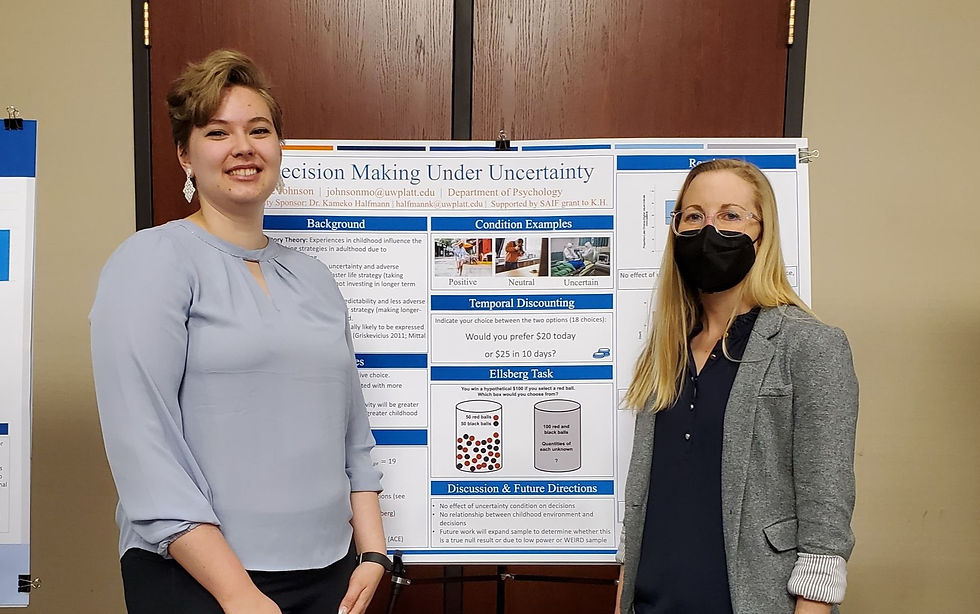Taking a leap of Faith: Risk Taking and Spirituality
- johnsonmo8
- Dec 24, 2022
- 1 min read

Macy Blabaum and I complete a study concerning the relationship between Risk-taking and spirituality primes. The results of this study show there is no correlation between these variables. We presented these findings at the 2022 Tri-state conference at Loras College in Dubuque, Iowa.
Background
Risk-Taking: The selection of an option that presents more variability (wider range of positive and/or negative outcomes) (Figner & Weber 2011).
Spirituality (Santos & Michaels 2022): A multidimensional concept that is represented by...
Self and values
Religious beliefs
Existential connection
Life force
Transcendence
Meaning
Previous studies have found mixed results to the effects of spiritualty on risk-taking. This study's goal was to contribute to that discussion.
Hypotheses
Reminders of spirituality will increase the amount of expected involvement in risky behavior,
We predict no significant difference of expected involvement or risk behavior between the neutral condition and the control condition while there will be a difference in the spiritual condition.
We predict no significant difference in risk-taking between those with high levels of supernatural beliefs and those with low levels of supernatural beliefs across all conditions.
Methods
Participants/sample:
158 UW-Platteville students (94 Male, Mean Age = 19.53, 91.1% white)

Supernatural Belief Scale (Jong, Bluemke & Halberstadt 2013)
Participants reported their supernatural belief across 10 statements on a nine-point Likert scale (-4 strongly disagree to 4 strongly agree). Statements included:
there exists an all-powerful, all-knowing, loving God.
There exists an evil personal spiritual being, whom we might call the Devil.
There exist good personal spiritual beings, whom we might call angels.
There exist evil, personal spiritual beings, whom we might call demons,
Human beings have immaterial, immortal souls.
There is a spiritual realm besides the physical one.
Some people will be rewarded in an afterlife when they die.
Some people will be punished in an afterlife when they die.
Miracles-divinely-caused events that have no natural explanation-can and do happen.
There are individuals who are messengers of God and/or can foresee the future.
Spiritual Prime
Alex woke up at 7 o’clock on a warm summer morning. They were awoken by a divine presence in the room. Alex looked out of the window and spent a long time looking over the gorgeous landscape. They were feeling particularly grateful to live in such a sacred world. Alex decided it would be a good day to reflect on the ethereal emotions they were feeling.
After reading the prime the participant was asked to recall:
what was the person's name?
What time did they wake?
What did they do right after they woke up?
What did they plan to do that day?
Neutral Prime
Alex woke up at 7 o’clock on a warm summer morning. Feeling thirsty, they went downstairs and poured a glass of water from the pitcher in the fridge. It was very cool and refreshing, so their thirst was quenched. The weather was supposed to get pretty hot later that day. Alex decided it would be a good time to go swimming.
After reading the prime the participant was asked to recall:
what was the person's name?
What time did they wake?
What did they do right after they woke up?
What did they plan to do that day?
Cognitive Appraisal of Risky Events (C.A.R.E.) Scale (Fromme, Katz, Rivet 1997).
Participants completed the Cognitive Appraisal of Risky Events (CARE)- Scale 2 Expected Involvement as the dependent variable in this study. The scale is rated on a seven-point Likert scale (1 Not at all likely to 7 Extremely likely) across 30 statements. The participant was to rate their expected involvement in next six months in the action that was stated. The scoring of the scale was broken down into six subscales:
Illicit drug use -i.e., Trying/using drugs other than alcohol or marijuana.
Aggressive and illegal behaviors- i.e., Damaging/destroying pubilc property.
Risky sexual activities- i.e., Having sex without protection against sexually transmitted diseases.
Heavy drinking- i.e., Playing drinking games.
High risk sports- i.e., Rock or Mountain climbing
Academic/ work behaviors -i.e., Missing class or work.
Results

F(36, 55) = .61, p= .94

p= .769, r =.024

Males: Mean = 2.45, Standard Deviation= .87
Females: Mean= 2.57, Standard Deviation= 1.23
t(152) = -.69, p= .49
Discussion & Future Directions
Reminders of spirituality did not increase the amount of expected involvement in risky behavior. Hypothesis one is not supported.
No significant difference of expected involvement of risky behavior between eh neutral, spiritual, and control conditions. Hypothesis two is partially supported
No significant difference in risk taking between those with high levels of supernatural beliefs and those with low levels of supernatural beliefs across all conditions. Hypothesis three is supported.
An additional exploratory analysis was completed to consider the effect of gender on risk-taking. There was no significant difference found.
Some limitations include convince sampling and potentially ineffective priming. Therefore, future research should seek to find the effect of direct versus indirect priming concerning spirituality.
References
Figner, B., & Weber, E. U. (2011). Who takes risks when and why?: Determinants of risk taking. Current Directions in Psychological Science, 20(4), 211–216. DOI: 10.1177/0963721411415790
Fromme, K., Katz, E. C., & Rivet, K. (1997). Outcome expectancies and risk-taking behavior. Cognitive Therapy and Research, 21(4), 421-442.
Jong, J., Bluemke, M., & Halberstadt, J. (2013). Fear of death and supernatural beliefs: Developing a new supernatural belief scale to test the relationship. European Journal of Personality, 27(5), 495–506. DOI:10.1002/per.1898
Santos, C., & Michaels, J. L. (2022). What are the core features and dimensions of “spirituality”? Applying a partial prototype analysis to understand how laypeople mentally represent spirituality as a concept. Psychology of Religion and Spirituality, 14(1), 10–20. Retrieved from: https://doi.org/10.1037/rel0000380




Comments